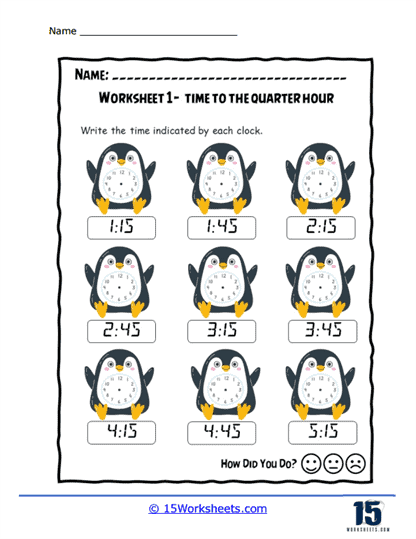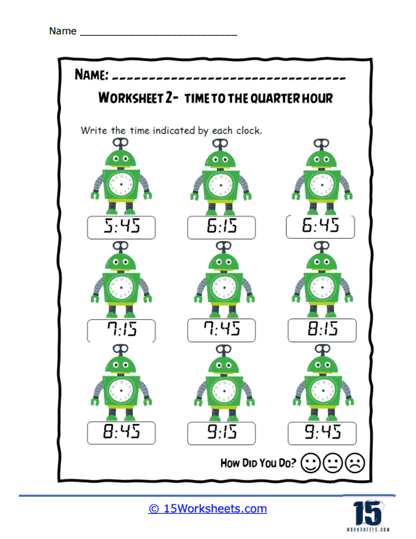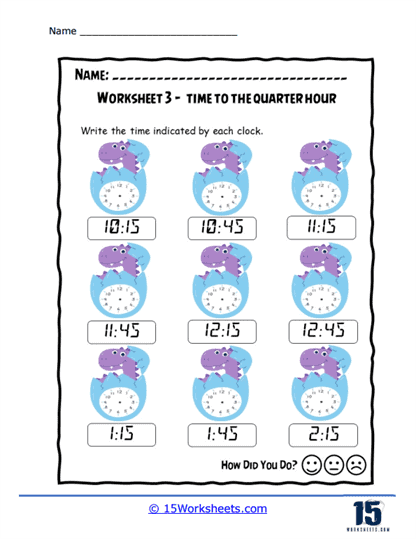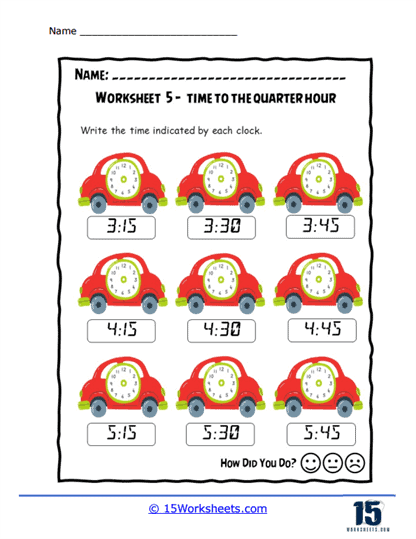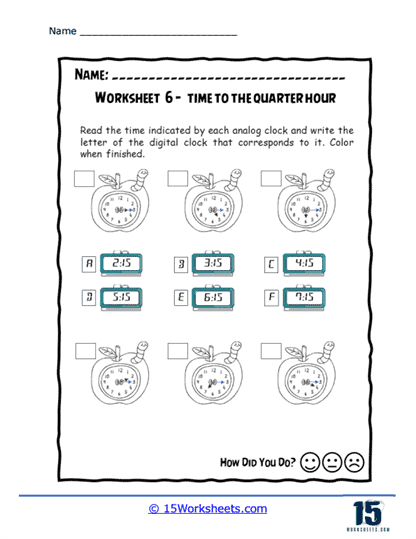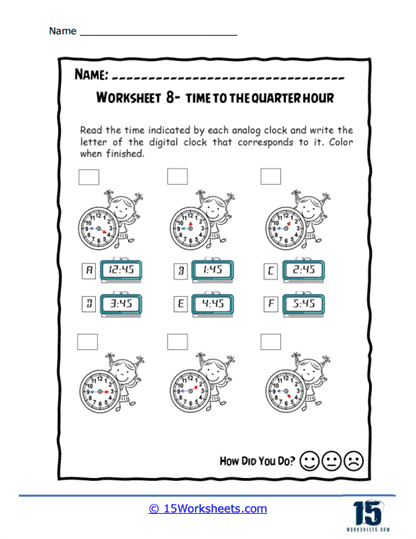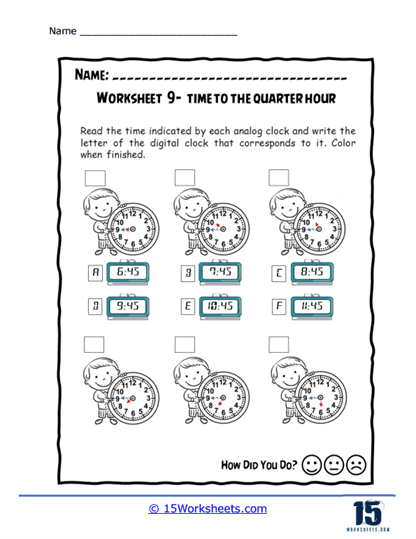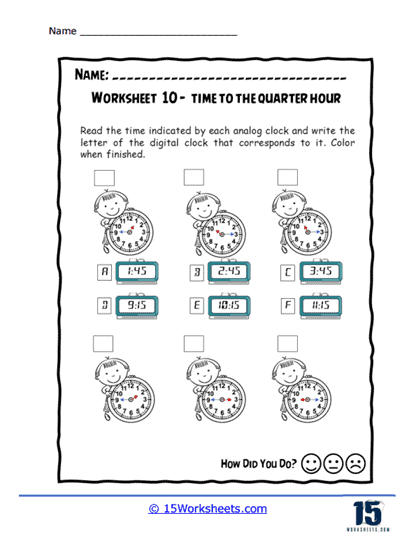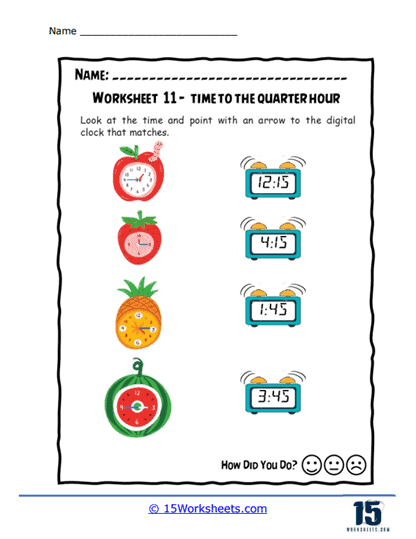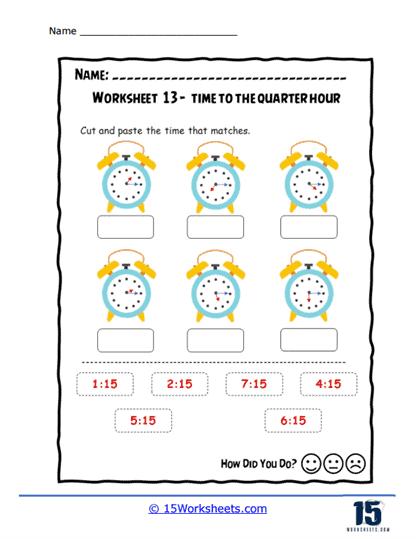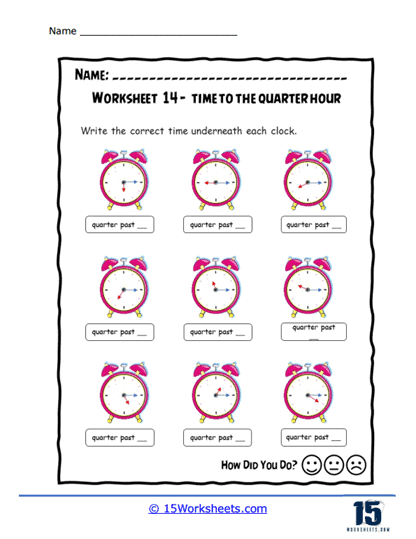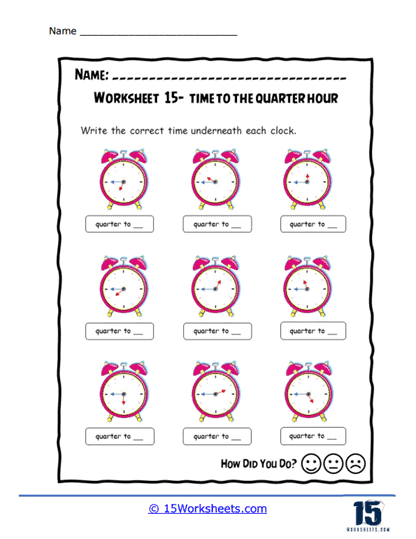Time to the Quarter Hour Worksheets
About These 15 Worksheets
These worksheets help students learn how to read and interpret analog clocks, specifically focusing on quarter-hour increments. These worksheets present various exercises that require students to identify, write, and match times shown on analog clocks. Each activity is designed to enhance a student’s understanding of how time progresses in quarter-hour intervals, which includes times like 15 minutes past the hour, 30 minutes past the hour (half-past), 45 minutes past the hour (quarter to), and on the hour.
The worksheets typically feature clocks with distinctive designs, such as colorful cars, cute animals, or playful themes, to make learning more engaging for children. These designs help maintain the interest of young learners while they practice essential time-telling skills.
Exercises on These Worksheets
These worksheets are designed to help students master the skill of reading and interpreting time on an analog clock, focusing on the quarter-hour intervals. These worksheets typically begin with basic exercises where students are presented with blank clock faces and asked to draw the hands to indicate specific quarter-hour times. For example, students might be instructed to draw the hands showing 3:15, 6:45, or 9:00. This exercise helps students understand the correct positioning of the hour and minute hands and reinforces the concept of quarter-hour intervals on the clock face.
Another common type of problem involves reading clock faces and writing down the time shown. In these exercises, students are given clock faces with the hands already drawn at quarter-hour intervals and must identify and write the corresponding time. For instance, a clock might show the minute hand at the 3 (indicating 15 minutes past the hour) and the hour hand slightly past the 2, and students would write “2:15.” These problems help students practice recognizing and interpreting the positions of the hands and associating them with specific times.
Worksheets also include matching exercises, where students are given a series of clock faces showing different quarter-hour times and a list of written times. They must match each clock face to the correct written time. This type of exercise reinforces the connection between visual and written representations of time and helps solidify their understanding of telling time to the quarter hour.
In addition to these fundamental exercises, some worksheets incorporate real-life scenarios and word problems to provide context for time-telling skills. For example, a problem might describe a daily routine, such as “Breakfast is at 7:15 AM, school starts at 8:00 AM, and bedtime is at 8:45 PM.” Students would then be asked to draw the appropriate times on blank clock faces or identify the times shown on provided clocks. These problems help students see the practical application of telling time and understand how it fits into daily activities.
Sequencing exercises are another type of problem that might be found on these worksheets. Students are given a series of events with their times listed (e.g., “Wake up at 6:45 AM, lunch at 12:15 PM, dinner at 6:00 PM”) and must put them in the correct order. These exercises help students understand the chronological flow of time and improve their ability to organize and sequence events.
The Benefits Of These Worksheets
Learning how to tell time to the quarter-hour provides several significant benefits, particularly for young learners. One of the primary advantages is the development of a deeper understanding of the passage of time. By mastering the concept of quarter-hour intervals, students gain a more nuanced comprehension of how minutes accumulate to form larger units of time. This foundational skill enhances their ability to conceptualize and measure time, which is essential for both academic progress and daily life.
Another key benefit is the reinforcement of arithmetic skills. Telling time to the quarter-hour requires students to work with the numbers 15, 30, and 45, which helps them understand and apply the concept of quarters and fractions in a practical context. This practice strengthens their ability to perform addition and subtraction, as they must calculate time intervals and differences. Additionally, it lays the groundwork for more complex mathematical concepts involving fractions and division, making it easier for students to grasp these topics in the future.
Learning to tell time to the quarter-hour also promotes better time management and organizational skills. When students can accurately read and interpret quarter-hour increments, they are better equipped to manage their schedules and plan their activities. This skill is crucial for prioritizing tasks, setting deadlines, and allocating time effectively. It helps students develop a sense of responsibility and independence as they learn to organize their daily routines, balance schoolwork with extracurricular activities, and meet important deadlines.
Real World Application Of This Skill
In the real world, the ability to tell time to the quarter-hour is indispensable in numerous everyday situations. For instance, in educational settings, students often need to follow schedules that include specific start and end times for classes, breaks, and activities. Knowing how to read quarter-hour intervals ensures that they arrive on time and transition smoothly between different parts of their day. Teachers also rely on precise time-telling to manage classroom activities, allocate time for lessons, and maintain a structured learning environment.
In professional contexts, telling time to the quarter-hour is vital for productivity and coordination. Employees often schedule meetings, appointments, and tasks that start or end at quarter-hour intervals. For example, a meeting might be scheduled from 9:15 AM to 9:45 AM, and knowing how to read this time accurately ensures punctual attendance and efficient time management during the meeting. Professionals in fields such as healthcare, transportation, and hospitality depend on precise time-telling to coordinate services, manage appointments, and maintain smooth operations.
In personal life, telling time to the quarter-hour is essential for managing daily routines and activities. Whether it is catching a bus that leaves at 7:45 AM, cooking a meal that requires precise timing, or coordinating family schedules, knowing the exact time is crucial. Parents use this skill to help children develop good habits, such as getting ready for school on time or going to bed at a consistent hour. Accurate time-telling also plays a significant role in social interactions, such as meeting friends for coffee or attending events where punctuality is expected.

